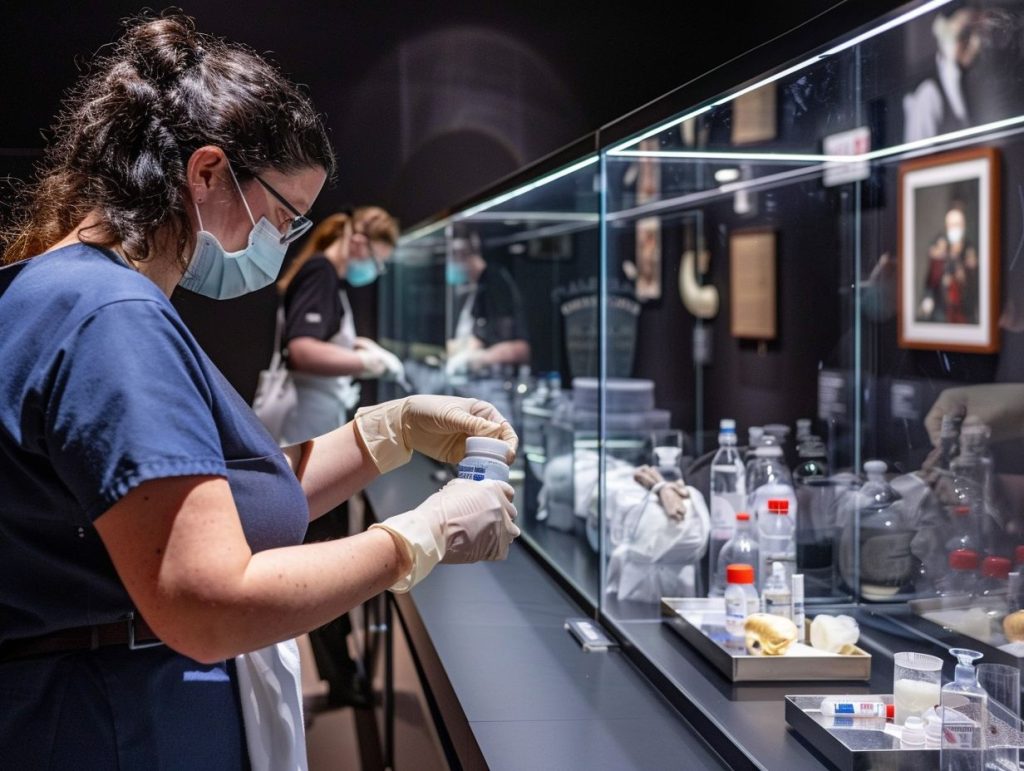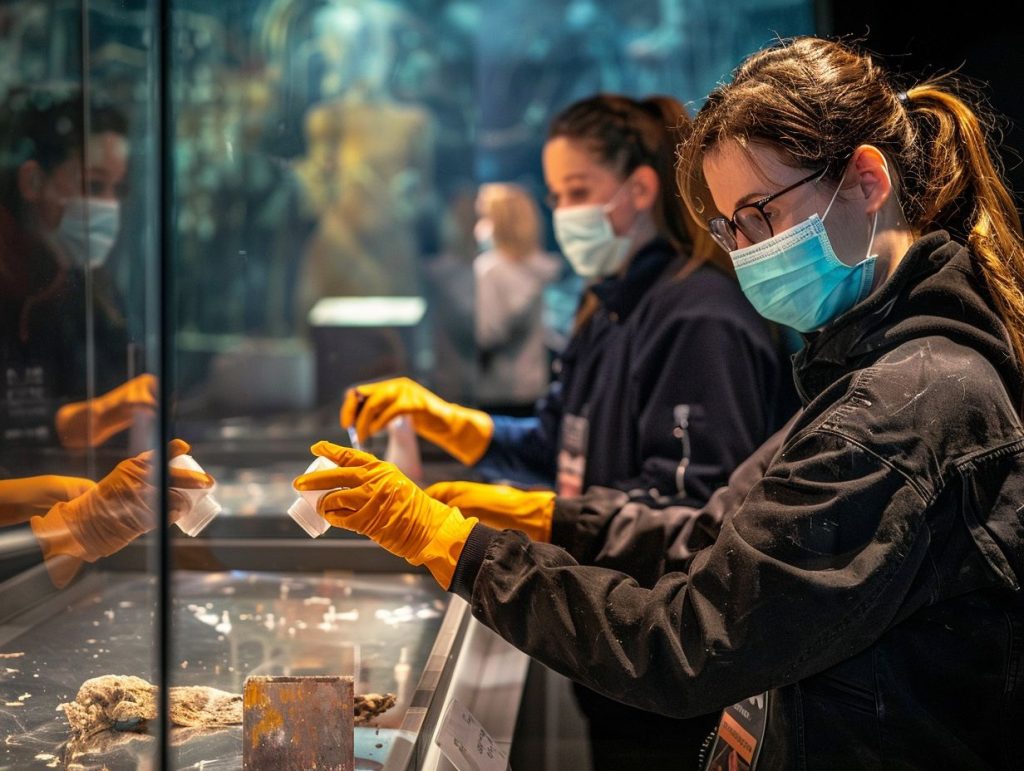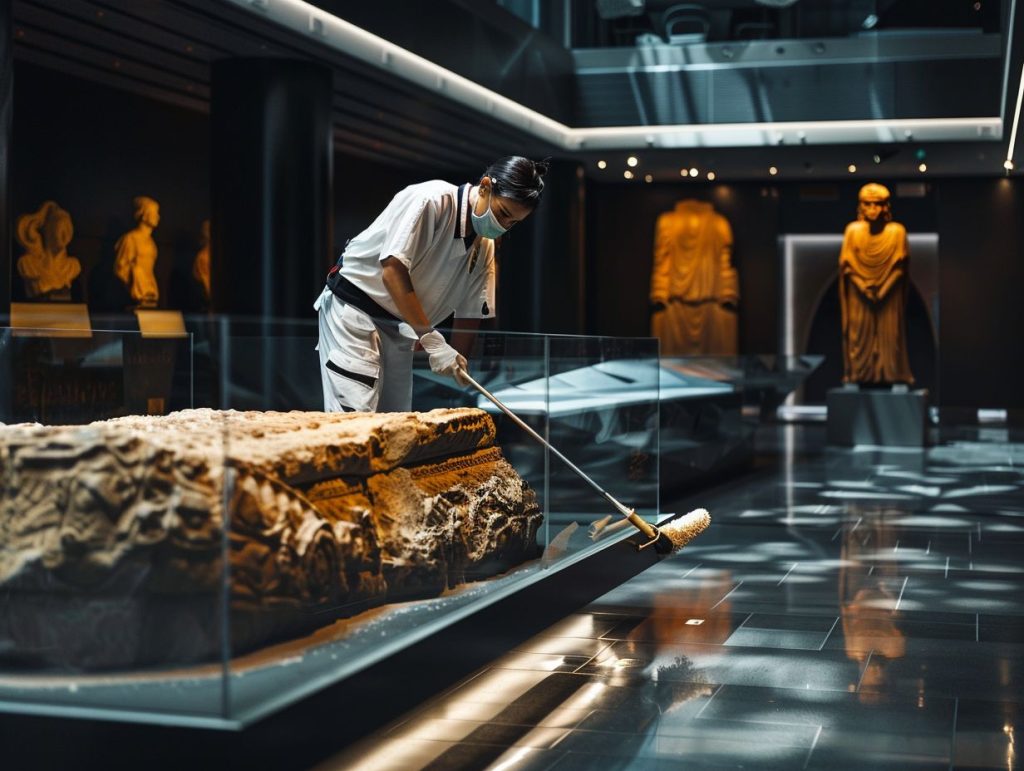Museums are like treasure troves filled with culture and history, but let’s face it—those high-contact points can bring some health risks for visitors like you.
We analyse what high-contact points actually are, giving definitions and examples while also highlighting the potential health risks they might carry. You’ll find helpful tips on effective cleaning and disinfection strategies and alternative solutions to help minimise contact.
Plus, safety guidelines for visitors and best practices for museum staff are included, all geared towards ensuring everyone has a safe and enjoyable experience.

Recognising High-Contact Points in Museums
High-contact points in museums are key areas where you, as a visitor, often interact, and getting a grip on these touchpoints is extremely important for enhancing your experience while keeping health and safety in mind.
Think about surfaces like exhibition displays, interactive installations, and visitor information kiosks—they receive a lot of daily traffic! By paying proper attention to these areas, museums can significantly reduce the risk of spreading infections, ensuring everyone can enjoy a safe environment during their visit.
Definition and Examples
In museums, high-contact points are surfaces and areas you frequently touch, such as exhibit cases, interactive displays, and information stands. These spots are crucial for engaging with the exhibits on a personal level.
For example, touchscreens can provide detailed information about artefacts or even allow you to dive into immersive experiences through augmented reality. Handrails and guided tour devices also enhance safety and accessibility, inviting you to interact more.
However, these touchpoints can also raise health concerns, so rigorous cleaning protocols are necessary. Museums must adhere to frequent sanitation schedules, especially during peak visiting hours. This way, they can create a safe environment, ensuring you feel comfortable engaging with the exhibits and enjoy your overall museum experience even more.
Potential Health Risks
Understanding the potential health risks linked to high-contact points in museums is essential. This knowledge helps you develop effective infection control measures prioritising visitor health and public safety.
These risks mainly come from transmitting pathogens through surfaces that many visitors touch. If these surfaces are not properly managed, they can lead to disease outbreaks, and that’s something to avoid.
Identifying and Addressing Potential Risks
Identifying and tackling potential health risks in museums means conducting a thorough risk assessment of all high-contact points. Then, you can implement appropriate cleaning schedules and health guidelines.
This process is crucial since museums welcome a wide variety of visitors who interact with exhibits, displays, and shared spaces daily. To effectively spot these risks, start with a detailed inventory of all the surfaces and items that get touched frequently, such as handrails, door handles, and interactive exhibits.
Next, Hazard Identification and Risk Assessment (HIRA) methodologies can help you categorise risks based on their likelihood of occurring and potential impact. After that, you should prioritise cleaning schedules that consider how often things are touched and the materials used in exhibits. This way, you’ll ensure resources are allocated precisely where they’re needed most.
By adhering to health guidelines, museums boost visitor safety and build trust and comfort among attendees, significantly reducing the chances of health-related incidents.

Making High-Contact Points Safe for Visitors
Making high-contact points safe for visitors is extremely important if you’re looking to enhance their comfort and trust in your museum. You can achieve this using effective cleaning and disinfection strategies for these surfaces.
By implementing touchless technology and following rigorous sanitisation practices, you can significantly reduce the chances of infection spreading, creating a much safer environment for everyone.
Effective Cleaning and Disinfection Strategies
Effective cleaning and disinfection strategies in museums are crucial to keeping those high-contact areas spotless and ensuring the health and safety of all visitors. You will want to create detailed cleaning protocols that specify which disinfectants to use on different surfaces and ensure your staff consistently follows these maintenance routines.
These protocols should outline the specific types of disinfectants that work best for various surfaces. For instance, you could use alcohol-based solutions for a quick dry clean on worktops and gentle cleansers for delicate artefacts that need extra care.
Do not forget to incorporate advanced cleaning technology, such as electrostatic sprayers. They boost the effectiveness of your cleaning efforts, ensuring even those tricky spots do not go neglected. Regular maintenance is crucial, too. It helps maintain that initial cleanliness and shows your commitment to visitor safety, building trust and encouraging people to return.
Alternative Solutions for Reducing Contact
Alternative solutions for reducing contact at high-contact points in museums include using technology to create contactless interactions, which enhances your experience while keeping safety and wellness in mind.
Digital exhibits allow visitors to explore collections through interactive screens or augmented reality. This makes the visit more captivating and reduces the need to handle objects physically.
Contactless ticketing systems make entering the museum easy, allowing you to enjoy your visit without waiting in a queue or exchanging cash—especially appealing in today’s climate.
Let’s not forget about safety barriers, such as transparent acrylic screens, which help respect personal space while keeping visitors’ flow smoothly. Altogether, these innovative strategies strengthen health protocols and make your museum experience all the more enjoyable.
Visitor Safety Measures
Visitor safety measures ensure you and all other visitors feel comfortable and secure during your museum experience. You can achieve this by following comprehensive health guidelines and safety protocols.
These measures cover a range of aspects, from crowd management strategies to ensuring enough space for everyone to move around safely, allowing for social distancing in public areas.
Guidelines for Visitors to Follow
Museums should set clear guidelines for visitors to ensure a safe and enjoyable experience. These include health certifications and hygiene practices that assist with disease prevention efforts.
These guidelines should cover essential hygiene practices, such as mandatory hand sanitising stations at key entry points and near interactive exhibits. Additionally, they should encourage social distancing to keep everyone safe.
Museums should also get creative with awareness campaigns to educate you about these measures. You will see signs and informational leaflets throughout the facility, making it easy to stay informed. By reinforcing these guidelines and educating visitors, museums create a safety culture and give you the power to take charge of your health and the well-being of those around you during your visit.
Implementing Health-Safe Practices in Museums
Implementing health-safe practices in museums is extremely important for creating a culture of safety that prioritises staff and visitor well-being. You will want to focus on ongoing training and regular safety audits to keep everyone informed and prepared.
These practices should include detailed operational guidelines covering visitor health checks and the use of personal protective equipment when necessary.
Best Practices for Museum Staff
Best practices for museum staff are crucial for creating a safe environment. That means you must focus on thorough training on safety measures, cleaning protocols, and effective communication with visitors and fellow team members.
When every team member understands their role in keeping things hygienic and safe, you can significantly reduce the risk of incidents and enhance the overall visitor experience. By emphasising the importance of sticking to established cleaning protocols, you protect public health and reassure visitors that their well-being is a top priority.
Effective communication is just as vital. It helps you convey essential safety information to visitors while encouraging them to share their experiences and feedback. That feedback becomes invaluable for continuously improving safety practices and tweaking protocols to meet the needs of everyone in attendance.
